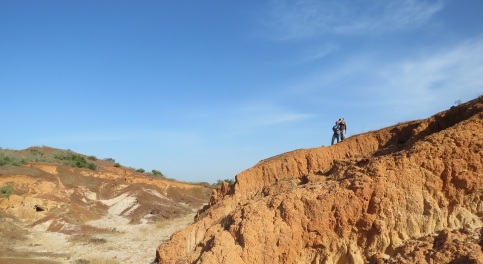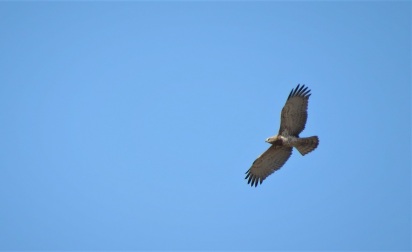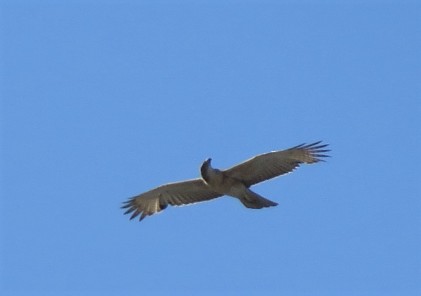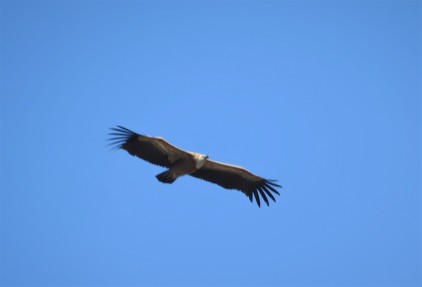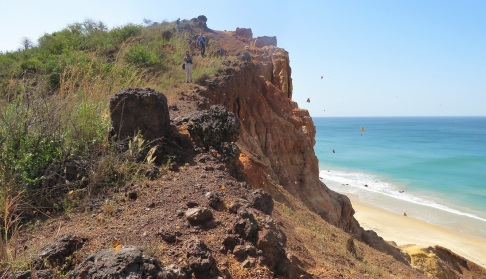Popenguine Raptor Fest (3.11.18)
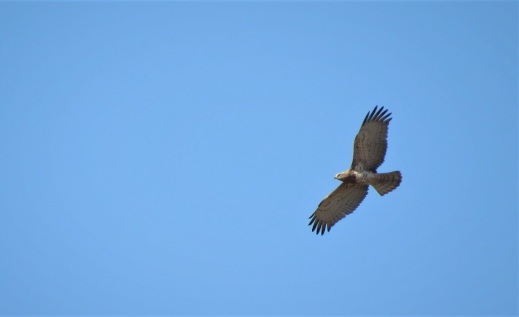
A visit to Popenguine nature reserve a couple of weeks ago quickly turned into a exciting few hours watching a good variety of raptors – something we’re not much used to in this part of Senegal, where there are few sites that are good for raptors, and most of the time anything else than a Yellow-billed Kite, Osprey or Hooded Vulture will qualify as a good record. Here’s a short overview, in order of appearance!
As always, several Ospreys were to be seen in the reserve; a few birds usually spend the night on the mighty baobabs that dot the Popenguine savanna, and all day long Ospreys can be seen flying around the cliffs or fishing out at sea. Later that same day at the lagoon just south of Toubab Dialaw, we had a good count of some 29 birds, all visible at the same time (Balbuzard). Popenguine of course also had a few Yellow-billed Kites patrolling the area (Milan à bec jaune).
As we were looking for a Common Rock Thrush we’d briefly spotted on a ridge ahead of the footpath, we noticed first an immature Peregrine Falcon flying around, then a European Hobby – the latter a scarce migrant through Senegal so always a good find. Hobby was already seen at Popenguine around the same time last year by Miguel. This time round it looked like it was an actively migrating individual, just like a Common Kestrel that briefly made an appearance shortly after (Faucons pèlerin, hobereau et crécerelle).
Next up was a Marsh Harrier circling in the distance, again probably a bird on its way to wintering grounds further south (Busard des roseaux). I’ve always thought that Popenguine would be a fairly strategic site to look for actively migrating raptors and other birds. Should be interesting to spend a few days here in October-November and February-March!
This Short-toed Eagle on the other hand was probably one of the 2-3 birds that typically spend the winter in the area around Popenguine and Guereo.
Far less expected than the previous species was an African Hawk-Eagle, spotted by Gabriel as it arrived from the north-east and made its way towards the cliffs, at one point circling together with a couple of Ospreys. Initially we weren’t quite sure about its identity and tentatively id’d this bird as a Bonelli’s Eagle, wondering whether a juvenile African Hawk-Eagle could be ruled out, and were a bit puzzled by the very pale appearance of this eagle. Luckily I managed a few record shots, a bit distant and hazy but they should do the trick. The plumage seemed to still be within the variation of worn juvenile Bonelli’s Eagle, but moult should not start until the second year and this bird shows clear moult contrast on with fresh inner primaries growing. Simon was the first to point out, after this post was originally published, that it looked more like African Hawk-Eagle. I eventually sent out the picture for comments, and Dick Forsman kindly responded, confirming that it’s an African Hawk-Eagle: “It is overall lighter below, the juvenile remiges (primaries + secondaries) are too light and too poorly barred below for a juv. Bonelli’s and the replaced inner primary shows just a dark tip without any further barring. Note also the translucent primaries in the images with blue sky, another pro-spilogaster feature.” Thanks Dick! (post updated Dec. 27)
African Hawk-Eagle is reasonable common it seems through the southern half of Senegal, and is a classic sighting e.g. in the Niokolo-Koba area. There are some records from the Saloum delta and even from the middle Senegal valley (as per Morel & Morel and Sauvage & Rodwell), but as far as I know this is the first from the Petite Côte.
I’m still hoping to see Bonelli’s Eagle one day in the Djoudj, Trois-Marigots or elsewhere in the Senegal valley, the only area with more or less regular records in winter (mainly by Frédéric, who year after year has documented the presence of a few birds around Saint Louis and who nicely summarised the current knowledge about this scarce species in West Africa, in this post on Ornithondar).
After we’d reached the top of the cliffs, next up was this Eurasian Griffon which appeared to be actively migrating along the coastline, just like a second bird we’d see a couple of hours later that same morning near Yène.
Barely a few minutes later, Gabriel strikes again with a young Lanner making a brief appearance, just as we were heading back towards the reserve entrance (Faucon lanier). That’s four species of falcons, not bad! In previous years we’ve also had Barbary Falcon near the cliffs, and surely Red-necked Falcon and Grey Kestrel must also occur at least occasionally, while in the wet season it may be possible to encounter African Hobby.
We thought we’d seen pretty much everything when at the last minute a Shikra was seen dashing over the pond (all but dry!), bringing our morning’s total to 11 birds of prey.
Besides all these hooked beaks, as always the nature reserve held quite a few other good bird, such as Gosling’s Bunting, Green-winged Pytillia, Sahel Paradise-Whydah, Blue Rock Thrush, and Northern Anteater Chat. In the end we saw two different Common (=Rufous-tailed) Rock Thrushes, a scarce migrant in Senegal, see this post on our first encounter with the species, in February 2016 at… Popenguine! Also a decent flock of Pallid Swifts and a few White-throated Bee-eaters, both pretty good bonus species, while two Pygmy Kingfishers including at least one dark-billed juvenile provided proof that the species is breeding here.
Complete eBird checklist available here.
The bird list for the Popenguine reserve now stands at some 198 species, at a minimum that is: I listed more than 20 other species as being most likely present, but which apparently remain to be confirmed. More on that over here.
Oh and then there were the butterflies – pure magic! Thousands and thousands of butterflies everywhere, especially along the track up the cliffs. With every footstep, small clouds of butterflies would explode, while a constant stream of butterflies was passing by the cliffs. Our visit clearly took place during peak migration season of Painted Lady which were the vast majority, and to a lesser extent some pieridae. And loads of dragonflies! Difficult to capture on camera but if you look carefully at the image below you’ll get a bit of a sense of what I’m trying to explain here.
Unseasonal visitors…

During our most recent excursions, we obviously looked out for those colourful Afro-tropical migrants that typically arrive in June-July, moving north with the rains – think cuckoos, rollers, kingfishers, etc. We saw some of course, especially at Wassadou but even in the bone-dry landscapes of Gossas and Diourbel, where we had migrants such as Diederik Cuckoo and Grey Hornbills.
Less expected were a number of breeders from the Western Palearctic that are now supposed to be in full breeding mode, so I thought it would be interesting to review these here. Of course, numerous “WP” species that winter in Senegal can be seen here year-round, but these are mostly waterbirds such as Eurasian Spoonbill, Black-tailed Godwit, Audouin’s Gull and other waders, gulls and terns. Many young birds of these species will actually remain in West Africa during their first summer, and from the end of June it’s quite normal to see early returnees, particularly for waders that failed their breeding season and left Europe early.
A Western Marsh Harrier (Busard des roseaux), probably a young female, flew over the flock of Greater Flamingos and other waterbirds that we’d just been counting at Lac Mbeubeusse, one of the niayes wetlands on the Cap-Vert peninsula, then landed in a reedbed. Some summer observations are known from both Senegal (“a few birds summer”, Morel & Morel) and Mauritania (June-August; Isenmann et al.), and Barlow & Wacher mention that occasional non-breeders are seen “during the rains” (a rather vague way to refer to summer, which doesn’t really tell us whether the records were actually during summer or whether they refer to regular migrants in September & October!).
Also here on the same day (23.6) was at least one immature Purple Heron (Héron pourpré) which may be either an oversummering bird of European origin, or a wandering African bird – I’m yet to figure out whether the species breeds anywhere nearby, though it’s clear that in potential breeding areas such as Technopole the species is absent during ~March to early August (further south, I have records from May-June, in Kolda and Toubacouta).
Still at Mbeubeusse – a decent birding site I’d never visited before despite being not far from Dakar! Never too late… – we also saw a winter-plumaged Knot (Bécasseau maubèche), feeding together with a group of Grey Plovers and a handful of Greenshanks and Redshanks. (Pluvier argenté, Chevaliers aboyeur et gambette). While the latter three species are more or less to be expected at this time in Senegal, the summer record of Calidris canutus may be noteworthy.
Two subadult Yellow-legged Gulls (prob. 3rd c.y.; Goéland leucophée) were at Lac Rose on 23.6, resting together with a group of some 500 Lesser Black-backed and 200 Audouin’s Gulls (Goélands bruns et d’Audouin), several of which were ringed including a Portuguese bird that I’d already seen back in April at Technopole. Also in the group were two or three Kelp Gulls (Goéland dominicain). Yellow-legged Gull is rather scarce here at any time of the year so it was a nice surprise to see these; apparently the species has been “recorded in all seasons” in Senegambia (Barlow & Wacher). Both birds seemed to be typical nominate birds (i.e. from southern Europe) rather than atlantis birds from the Macaronesian islands.
A week earlier at Wassadou and along the road from Tambacounda to the Niokolo-Koba, we noted a good presence of Common & Pallid Swifts (Martinets noir et pâle), which appears to be not unusual at this time of the year since non-breeding birds are said to move north with the rains from their “wintering” grounds over the forest zone of West Africa. There are however few June records (e.g. Barlow & Wacher give a presence of Pallid Swift from July-September and November-January). Even more exciting was the presence of several Mottled Swifts (Martinet marbré) at Wassadou, the first June record of a “difficult” bird in the region – there appear to be less than 10 records for Senegal in total, all of which are from the Niokolo-Koba area. The one below was seen by my Swiss friends in the PNNK earlier this year.
Perhaps more surprisingly than the preceding species, two European Bee-eaters (Guêpier d’Europe) were feeding and flying around pretty much all afternoon on 23.6 in Almadies, Ngor, regularly calling in the process and as such giving away their presence above and near my house. I’d never seen the species before in Dakar (though I have seen them not far, along the Petite Côte in autumn), so this was a highly unexpected record. Paul Isenmann and colleagues mention that the species is present in Mauritania from July/August to October, and March to May/June, but I didn’t find any references to summer records in Senegal or Gambia. Probably just a coincidence, but earlier the same day we saw our first Blue-cheeked Bee-eaters in the Dakar region, at Lac Rose (Guêpier de Perse). Perhaps these were birds en route to their breeding grounds in northern Senegal?

European Bee-eater / Guêpier d’Europe (seen here on wintering grounds in coastal Casamance, March 2017)
A single House Martin (Hirondelle de fenêtre) at Wassadou on 15 & 16.6 was also remarkable: a very late migrant, an oversummering bird, or a wanderer that decided not to bother going all the way to Europe? The species has been recorded Oct. – June and I’ve seen birds as late as 28/5 at Technopole, but it’s clear that there are very few records from late June and July.
A Melodious Warbler (Hypolaïs polyglotte) photographed by Gabriel in the Niokolo-Koba park, at campement du Lion, on 17.6 is another rare mid-summer record of a species that typically arrives from mid-August and depart by May at the latest. Gabriel recently saw the species in the Boundou community nature reserve as well, so it seems that quite a few are staying around during summer. More generally, one can only wonder how many of these Palearctic passerines are here at the moment. Putting things in perspective, the observations in this post are all by just 3 active resident birders in the country…
A few kilometres further north, Miguel and I observed a Western Olivaceous Warbler (Hypolaïs obscure) at Wassadou, feeding in bushes on the edge of the Gambia river, on 16.6. This is of course a common to very common winter visitor throughout the country, and there are records from all month, so maybe not as surprising as the previous species. Now often called Isabelline Warbler, it is also known to be summering at Nouakchott (June-July) with no noticeable break between pre- and postnuptial passages (spring: March – May/early June, autumn: July-October; Isenmann et al. 2010).
A couple of days later near Diourbel, we had a Woodchat Shrike (Pie-grièche à tête rousse), apparently a first-summer male: the forehead is extensively black and mantle seems mostly jet-black (both features indicative of males), while the moult limit between the adult-type dark wing feathers and juvenile brownish unmoulted primary coverts and flight feathers are typical of 2nd calendar year birds (more on ageing & sexing the species here, from Blasco-Zumeta & Heinze’s excellent series on the topic). The presence of this species in Senegal is fairly similar to Western Olivaceous Warbler. An adult Great Spotted Cuckoo (Coucou-geai) earlier that day near Gossas was assumed to be an African rather than a northern migrant, though we can’t be sure of course; the date is consistent with the arrival of this cuckoo on its Sahelian breeding grounds (a couple of weeks later I had another adult, actively calling, though a bit further east: along the Niger river near Niamey).
Voilà for now; for me it’s time to migrate north for a couple of weeks (though no breeding for me this summer); I’ll be back towards the end of the month. And maybe find some time to finish a few blog posts that have been dormant in my draft folder for a while now… Thanks for reading!

